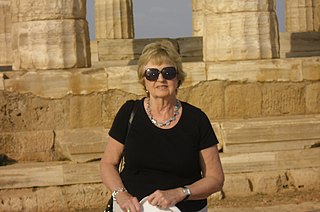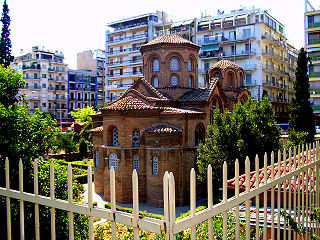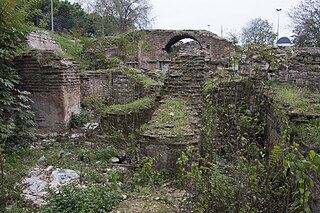Related Research Articles
Byzantine art comprises the body of Christian Greek artistic products of the Eastern Roman Empire, as well as the nations and states that inherited culturally from the empire. Though the empire itself emerged from the decline of Rome and lasted until the Fall of Constantinople in 1453, the start date of the Byzantine period is rather clearer in art history than in political history, if still imprecise. Many Eastern Orthodox states in Eastern Europe, as well as to some degree the Islamic states of the eastern Mediterranean, preserved many aspects of the empire's culture and art for centuries afterward.

Dumbarton Oaks, formally the Dumbarton Oaks Research Library and Collection, is a historic estate in the Georgetown neighborhood of Washington, D.C. It was the residence and garden of wealthy U.S. diplomat Robert Woods Bliss and his wife Mildred Barnes Bliss. The estate was founded by the Bliss couple, who gave the property to Harvard University in 1940. In 1944, it was the site of the Dumbarton Oaks Conference to plan for the post-WWII United Nations.

Spolia is repurposed building stone for new construction or decorative sculpture reused in new monuments. It is the result of an ancient and widespread practice whereby stone that has been quarried, cut and used in a built structure is carried away to be used elsewhere. The practice is of particular interest to historians, archaeologists and architectural historians since the gravestones, monuments and architectural fragments of antiquity are frequently found embedded in structures built centuries or millennia later. The archaeologist Philip A. Barker gives the example of a late Roman period tombstone from Wroxeter that could be seen to have been cut down and undergone weathering while it was in use as part of an exterior wall and, possibly as late as the 5th century, reinscribed for reuse as a tombstone.

Dame Averil Millicent Cameron, often cited as A. M. Cameron, is a British historian. She is an expert on Late Antiquity, Classics, and Byzantine Studies. She was Professor of Late Antique and Byzantine History at the University of Oxford, and the Warden of Keble College, Oxford, between 1994 and 2010.

Hosios Loukas is a historic walled monastery situated near the town of Distomo, in Boeotia, Greece. Founded in the mid-10th century, the monastery is one of the most important monuments of Middle Byzantine architecture and art, and has been listed on UNESCO's World Heritage Sites since 1990, along with the monasteries of Nea Moni and Daphnion.

Ernst KitzingerFBA was a German-American historian of late antique, early medieval, and Byzantine art.

A cross-in-square or crossed-dome plan was the dominant architectural form of middle- and late-period Byzantine churches. It featured a square centre with an internal structure shaped like a cross, topped by a dome.

Judith Herrin is a British archaeologist, byzantinist, and historian of Late Antiquity. She was a Professor of Late Antique and Byzantine Studies and Constantine Leventis Senior Research Fellow at King's College London.

Byzantine studies is an interdisciplinary branch of the humanities that addresses the history, culture, demography, dress, religion/theology, art, literature/epigraphy, music, science, economy, coinage and politics of the Eastern Roman Empire. The discipline's founder in Germany is considered to be the philologist Hieronymus Wolf (1516–1580), a Renaissance Humanist. He gave the name "Byzantine" to the Eastern Roman Empire that continued after the Western Roman Empire collapsed in 476 AD. About 100 years after the final conquest of Constantinople by the Ottomans, Wolf began to collect, edit, and translate the writings of Byzantine philosophers. Other 16th-century humanists introduced Byzantine studies to Holland and Italy. The subject may also be called Byzantinology or Byzantology, although these terms are usually found in English translations of original non-English sources. A scholar of Byzantine studies is called a Byzantinist.

The Church of St. Polyeuctus was an ancient Byzantine church in Constantinople built by the noblewoman Anicia Juliana and dedicated to Saint Polyeuctus. Intended as an assertion of Juliana's own imperial lineage, it was a lavishly decorated building, and the largest church of the city before the construction of the Hagia Sophia. It introduced the large-scale use of Sassanid Persian decorative elements, and may have inaugurated the new architectural type of domed basilica, perfected in the later Hagia Sophia.
Parastaseis syntomoi chronikai is an eighth- to ninth-century Byzantine text that concentrates on brief commentary connected to the topography of Constantinople and its monuments, notably its Classical Greek sculpture, for which it has been mined by art historians.

The Monza ampullae form the largest collection of a specific type of Early Medieval pilgrimage ampullae or small flasks designed to hold holy oil from pilgrimage sites in the Holy Land related to the life of Jesus. They were made in Palestine, probably in the fifth to early seventh centuries, and have been in the Treasury of Monza Cathedral north of Milan in Italy since they were donated by Theodelinda, queen of the Lombards,. Since the great majority of surviving examples of such flasks are those in the Monza group, the term may be used to cover this type of object in general.

Robin Sinclair Cormack, FSA is a British classicist and art historian, specialising in Byzantine art. He was Professor in the History of Art, Courtauld Institute of Art, University of London, 1991–2004.
Doula Mouriki was a Greek Byzantinologist and art historian. She made important contributions to the study of Byzantine art in Greece.
Leslie Brubaker is an expert in Byzantine illustrated manuscripts. She was appointed Professor of Byzantine Art at the University of Birmingham in 2005, and is now Professor Emerita. Her research interests includes female patronage, icons and the cult of the Virgin Mary. She was formerly the head of Postgraduate Studies in the College of Arts and Law, University of Birmingham. Professor Brubaker is the Chair of the Society for the Promotion of Byzantine Studies. Her work is widely stocked in libraries around the world.
Wendy Mayer is an Australian scholar in late antiquity and religion who is a research professor and associate dean for research at Australian Lutheran College, dean of research strategy for the University of Divinity, and honorary research fellow at the University of South Africa. She is known for her work on John Chrysostom and on early Christian preaching.
Arietta Papaconstantinou is Reader in Classics at the University of Reading and Associate Faculty Member in the Faculty of Oriental Studies, University of Oxford. She is an expert in the religious, social and economic history of Egypt and the Near East during the transition from the Roman Empire to the Caliphate.
Alice-Mary Talbot is director of Byzantine studies emerita, Dumbarton Oaks Research Library and Collection. Her particular expertise is the social context of Byzantine religious practices, including hagiography, monasticism and gender studies. Much of her work has focused on the edition and translation of Byzantine texts.
In the Byzantine Empire, cities were centers of economic and cultural life. A significant part of the cities were founded during the period of Greek and Roman antiquity. The largest of them were Constantinople, Alexandria and Antioch, with a population of several hundred thousand people. Large provincial centers had a population of up to 50,000. Although the spread of Christianity negatively affected urban institutions, in general, late antique cities continued to develop continuously. Byzantium remained an empire of cities, although the urban space had changed a lot. If the Greco-Roman city was a place of pagan worship and sports events, theatrical performances and chariot races, the residence of officials and judges, then the Byzantine city was primarily a religious center where the bishop's residence was located.
References
- 1 2 "ACLS American Council of Learned Societies | www.acls.org - Results". www.acls.org. Retrieved 2020-12-05.
- 1 2 "Faculty Profile > USC Dana and David Dornsife College of Letters, Arts and Sciences". dornsifelive.usc.edu. Retrieved 2020-12-05.
- ↑ Yasin, Ann Marie (2002). Commemorating the dead - constructing the community: Church space, funerary monuments and saints' cults in late antiquity (Thesis). ProQuest 305505162.
- ↑ Schroeder, Rossitza B. (2009). "Saints and Church Spaces in the Late Antique Mediterranean: Architecture, Cult, and Community – Bryn Mawr Classical Review". Bryn Mawr Classical Review. Retrieved 2020-12-05.
- ↑ "UCPress Editorial". online.ucpress.edu. Retrieved 2020-12-05.